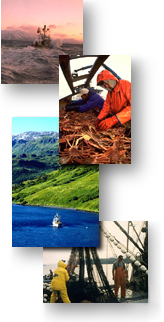Common names: King salmon, chinook salmon, spring salmon.
Regional names: Tyee salmon, winter salmon, quinnat salmon.
Identification: Bluegreen to black backs with black spots,
silver sides. Black spots on back and tail. Dark colored or black gums. Salmon
over 30 lbs are likely to be kings.
Range: Southern California, to Kotzebue Sound, Bering Sea and
northern Japan.
Season and Catch Methods: May to September from Gulf of Alaska
to Kotzebue Sound. Year-round in Southeast Alaska. Caught primarily by trolling
and in lesser quantities by seine and drift gillnet.
Size: Average 18 to 20 lbs, range 12 to 40 lbs,
Product forms: Fresh: dressed; dressed/headed; fillets,
skin-on or skinless, pin-bone in or boneless; steaks. Frozen: dressed/headed;
fillets, skin-on or skinless, pin-bone in or boneless; steaks. Canned: 1/4#,
1/2# and 1#. Dressed headed fish graded: 4-7 lbs, 7-11 lbs, 11-18 lbs and 18
lbs up. Steaks and fillets typically graded: 4-, 6-, 8-, 10- and 12 ounce
portions.
Packaging: Fresh and frozen dressed/headed fish 50, 80, and
100 lb boxes. IQF and vacuum packed frozen fillets and steaks 5 to 10 lb
cartons.
Nutritional Value (3.5 oz (100 g), raw fillet): 180 Kcal, 90
Kcal from Fat, 20 g Protein, 10 g Total Fat, 2.5 g Saturated Fat, 1.6 g Omega-3
Fat, 66 mg Cholesterol, 47 mg Sodium.
|




